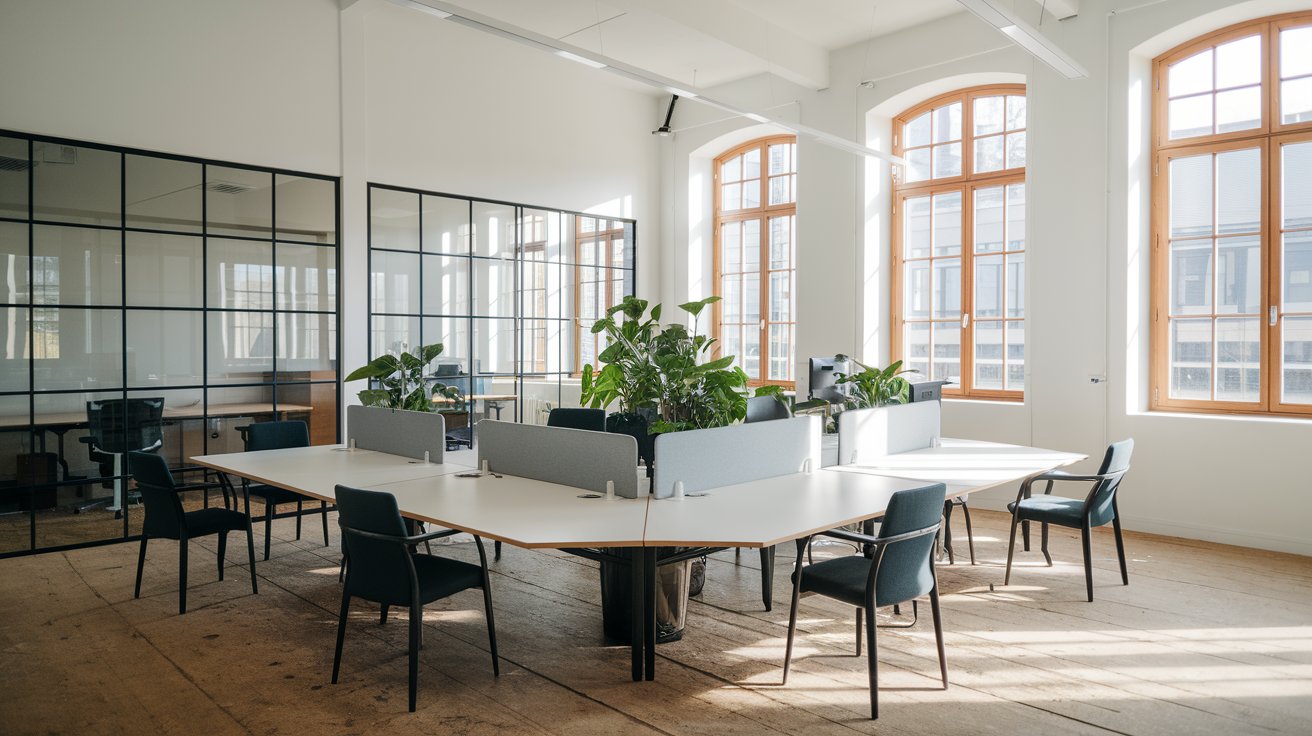Natural light plays a crucial role in creating a positive, energising, and productive workspace. The careful arrangement of office furniture, including corner desks, can significantly enhance the amount of natural light in a room, providing both physical and psychological benefits for employees.
In the modern workplace, where design is often focused on both aesthetic and functionality, the strategic placement of corner desks has become an important consideration for interior designers and business owners alike. Corner desks, with their unique L-shape design, offer ample space and flexibility for work, and when placed in the right position, they can help maximise the flow of natural light throughout the office.
In today’s world, an increasing number of studies suggest that exposure to natural light not only enhances mood but also improves focus, energy levels, and overall well-being. By strategically positioning office furniture to take full advantage of natural light, businesses can create a work environment that is both comfortable and efficient. This article will explore the advantages of corner desks in maximising natural light and offer practical tips on optimising their placement to enhance productivity and well-being in the office.
The Benefits of Natural Light in the Office
Natural light is one of the most important elements of an office environment. It has been scientifically proven that exposure to daylight can help reduce eye strain, enhance mood, and even boost overall performance.
Employees working in well-lit environments are often more energetic, less stressed, and less likely to experience fatigue. Furthermore, the ability to tap into natural light helps reduce the need for artificial lighting, leading to both environmental and financial benefits. It can significantly lower electricity consumption and reduce a business’s carbon footprint, contributing to a more sustainable workplace.
Corner desks, often seen as a solution to maximise space in a small or open-plan office, can also play a key role in optimising the benefits of natural light. By using these desks in conjunction with the room’s natural light sources, you can create a workspace that is both aesthetically pleasing and conducive to high levels of productivity. The L-shaped design of corner desks offers versatility, with plenty of space for working while ensuring that employees are not too far from natural light sources such as windows.
The Role of Corner Desks in Office Furniture Arrangements
Corner desks are an increasingly popular choice in office furniture design due to their practicality and space-saving qualities. These desks allow employees to spread out their work while keeping the space around them clear. However, beyond these practical advantages, corner desks are also an effective tool for optimising the placement of office furniture in relation to natural light. The right placement of a corner desk in the office can increase access to daylight, making a noticeable difference in the comfort and efficiency of the workspace.
One of the primary benefits of corner desks is their ability to maximise unused corners, allowing natural light to reach areas that would otherwise be in shadow. In an office with limited windows or where space is at a premium, corner desks can serve as a means to improve the overall distribution of light in the room. The strategic positioning of these desks can make the difference between a dreary, poorly lit space and a bright, uplifting environment that enhances focus and creativity.
Maximising Natural Light with Corner Desk Placement
1. Positioning Corner Desks Near Windows
The most obvious and effective way to maximise natural light in an office is to position corner desks as close to windows as possible.
By placing the desk in a corner where it has access to daylight from two adjacent walls, you can ensure that natural light floods the workspace from multiple angles. This will not only brighten the desk area but also provide a more even distribution of light throughout the entire room.
If possible, place the desk in a corner that faces a window, allowing the desk to catch the sunlight as it streams into the room. In this arrangement, employees can benefit from both direct sunlight and the natural light reflected off surrounding surfaces.
For optimal results, avoid placing the desk directly in front of the window to prevent glare on computer screens. Instead, position the desk so that it benefits from the natural light while allowing for a comfortable and glare-free workspace.
2. Using Light-Coloured Office Furniture
In addition to the strategic placement of corner desks, the colour of the office furniture plays a crucial role in maximising natural light. Lighter colours, particularly white or soft pastels, reflect light, which helps to distribute it more evenly throughout the space. Corner desks with light wood finishes or white laminate surfaces can help bounce natural light around the room, creating a brighter and more welcoming environment. Darker colours, on the other hand, tend to absorb light, which can make a space feel more confined and dim.
When choosing office furniture, consider incorporating light-coloured materials that will complement the flow of natural light into the room. This not only enhances the brightness but also contributes to the overall aesthetics of the workspace. By pairing strategically placed corner desks with light colours, you can further enhance the natural light coming into the office.
3. Avoiding Obstructions
It’s important to consider the placement of other office furniture and accessories when positioning corner desks. Tall cabinets, bookshelves, or other bulky furniture placed in front of windows can block natural light and create shadows in the room. To maximise the light entering the space, keep the area around the windows clear of obstructions. If additional storage is necessary, consider placing shelves or cabinets along walls that are further away from the window, ensuring that nothing blocks the light.
If your office layout requires that furniture be placed in front of windows, opt for lower storage units or transparent materials such as glass or acrylic. These materials allow light to pass through while still providing storage space.
4. Angling Corner Desks for Optimal Light Exposure
In some office layouts, corner desks may need to be angled slightly to allow for better access to natural light. Rather than positioning the desk directly against the wall, angle the desk so that it faces the window at a 45-degree angle. This ensures that the desk area is bathed in natural light from two different directions, helping to brighten up the workspace. The angle also reduces the chances of glare on computer screens, allowing employees to enjoy the benefits of natural light without the negative effects of direct sunlight.
5. Leveraging Reflective Surfaces and Mirrors
In addition to choosing light-coloured office furniture, reflective surfaces and mirrors can be used to amplify natural light in the office. By placing mirrors strategically around the room, you can reflect sunlight into areas that may not be directly illuminated by windows. This can be especially useful in offices with limited windows or where natural light is only available for part of the day. Reflective surfaces, such as glass table tops or polished metal finishes on corner desks, can also help bounce light around the room, further enhancing the overall lighting.
Conclusion
Maximising natural light in the office is an essential element of designing a productive and healthy workspace. Corner desks, with their unique positioning and spacious design, offer an ideal solution for utilising natural light to its fullest potential.
By placing these desks near windows, using light-coloured furniture, avoiding obstructions, angling the desk for optimal light exposure, and incorporating reflective surfaces, you can transform your office into a bright, energising environment that boosts mood, productivity, and well-being.
Thoughtful placement of office furniture, including corner desks, will ultimately help create a workspace that fosters creativity, focus, and success.




